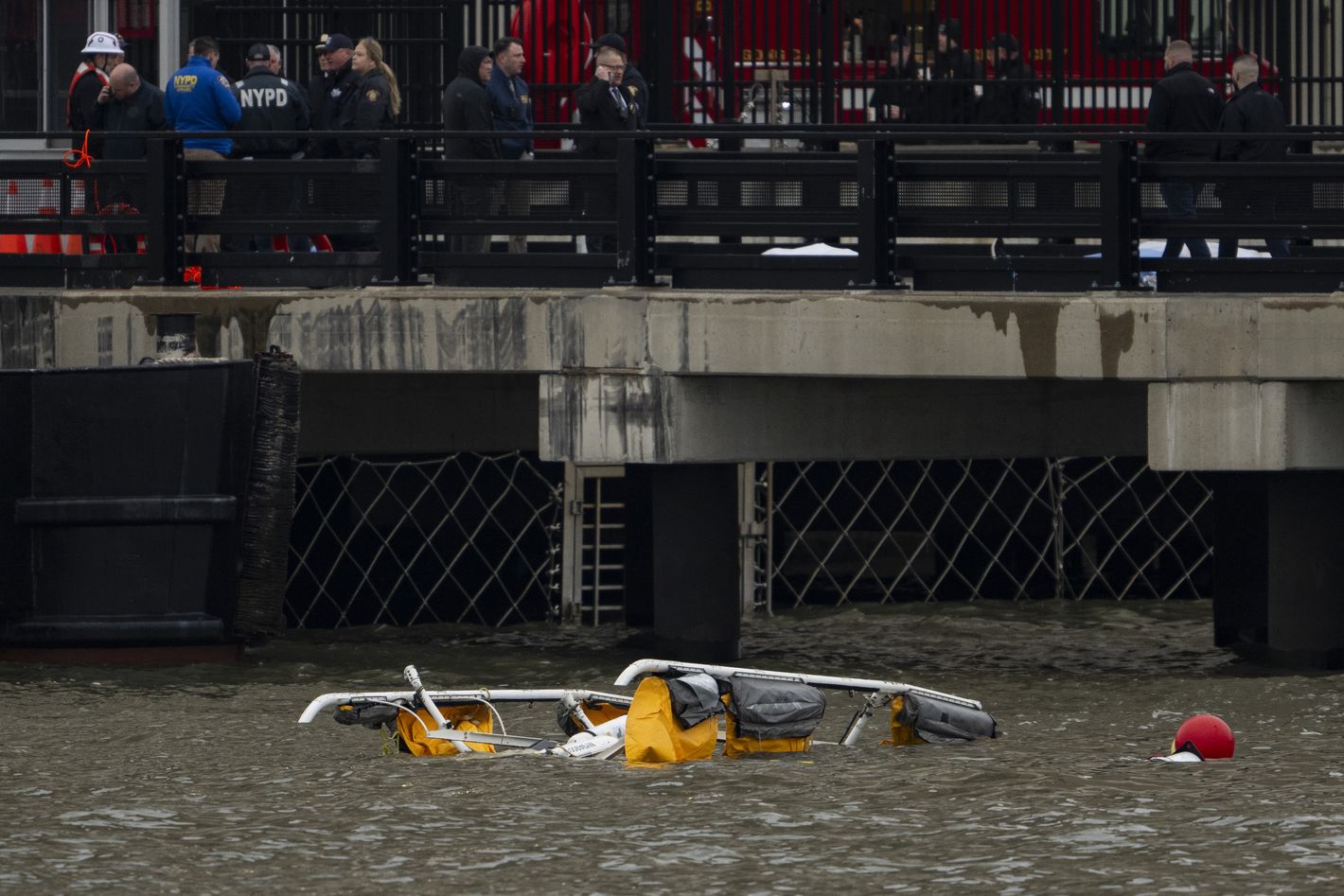Anadolu via Getty Images
The tourist helicopter that crashed into the Hudson River on Thursday afternoon appears to have fallen victim to a well-known hazard known as “mast bumping,” according to aviation experts. Eyewitness video showed the rotors and the body of the helicopter separating in midair. The phenomenon is unique to helicopters with semi-rigid rotors, like the Bell 206L4 LongRanger that fell out of the sky while flying a family of Spanish tourists. The pilot, two adult passengers, and three children were all killed.
The phenomenon of mast bumping arises from the physics of the rotor blades. Each helicopter blade is like a long, thin wing that generates lift as it carves through the air. Spinning at high speed, the blades form a whirring disk. The blades are attached to a hub that in turn is connected to a mast that projects vertically upward from the transmission. To visualize the relationship of the mast and the rotor hub, says Robert Joslin, a professor at Embry-Riddle Aeronautical University, in Daytona, Florida, “Think of a drinking cup upside down on the top of a broom handle. If you just move it back and forth a little bit, it won’t touch. But if you go real hard, the rim will hit the handle.” In the case of the helicopter, the hub is a fast-spinning hunk of metal that could bend the mast or break it altogether, severing the rotor and sending it flying.
— Breaking Aviation News & Videos (@aviationbrk) April 10, 2025
There’s another potential problem with moving the controls too vigorously. The helicopter blades are flexible, like a pool noodle. If you lower them quickly, their momentum will keep their tips moving in the same direction after the base of the blade has stopped. If the rear of the disk is moving downwards, says aviation attorney Jim Brauchle, “the rotor comes down and actually hits the body of the helicopter. And what we can see from the video that it looks like that’s exactly what happened, because the complete tail section is gone.”
Losing both tail and rotor at the same time will cause the fuselage to plummet, tumbling as it goes, while the tail falls separately and the rotor goes spinning off like a boomerang. The danger is so well-known for this kind of helicopter that the FAA includes a section explaining the risk in its Helicopter Flying Handbook.
The helicopter involved in Thursday’s accident was owned by a Louisiana company, Meridian Helicopters, and operated by New York Helicopter Charter of Kearny, New Jersey. According to flight data, the helicopter had picked up Siemens executive Augustín Escobar, his wife, and three children at the Downtown Manhattan Heliport at 2:59 p.m., then flew north along the Manhattan shore of the Hudson up to the George Washington Bridge before turning back and flying along the New Jersey side of the river. It was descending in preparation for landing at the heliport at the time of the accident.
It’s conceivable that a mechanical failure could have caused a breakage in the assembly that connects the rotor to the fuselage, allowing it to detach and fly free. This happened in 2016 to an Airbus helicopter that was ferrying workers to an oil platform in the North Sea. Video taken at the time shows the triple-bladed rotor spinning through the air.
However, that wouldn’t explain why the tail of the helicopter was chopped off.
At the time of the accident winds were strong and gusty, blowing at 20 mph from the south-southeast with gusts of up to 25 mph. While these kinds of wind speeds are not dangerous in themselves, wind moving over tall buildings — in this case, high-rises of lower Manhattan — can cause dramatic turbulence in much the same way that rocks in a stream can cause roiling currents downstream. “Turbulence is usually the main culprit in mast bumping,” Brauchle says.
The phenomenon can also occur as a result of certain maneuvers that are dangerous in semi-rigid rotor helicopters, such as when a pilot pushes the helicopter nose downward in a so-called “pushover.” This puts the aircraft in a low-g condition and creates the sensation of loss of control that can induce pilots to make fatally abrupt movements. An inexperienced helicopter pilot might do a pushover while arcing over a hilltop or while diving to avoid an oncoming aircraft.
Accidents involving tourist helicopters are not uncommon in the Manhattan airspace. It’s busy and involves a mix of fixed-wing and rotor aircraft that have to avoid one another without help from a control tower. Brauchle represented the family members of passengers aboard a sightseeing helicopter that collided with a light airplane near the Statue of Liberty in 2009. In 2018, a sightseeing helicopter flying with its doors off crashed near Roosevelt Island, killing all five passengers.
We may never know exactly what triggered the mast bumping that felled the Bell LongRanger 206 on Thursday. Helicopters of that size typically don’t carry black boxes that can help air-accident investigators and there are no survivors to clarify what was going on at the moment of upset. “Maybe he saw a flock of birds or something and tried to maneuver to avoid it or something,” Brauchle says. “I don’t know.”

